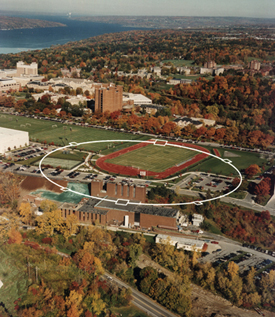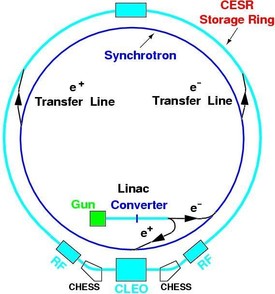Cornell Electron Storage Ring

CESR on the campus of Cornell University in Ithaca, New York.
Buried 40 feet beneath Alumni Field on the Cornell University campus is the 768 meter Cornell Electron Storage Ring (CESR). CESR was constructed as an electron-positron collider operating at a center-of-mass energy in the range of 3.5-12 GeV. CESR is now used as an x-ray source for a state-of-the-art x-ray facility, known as the
Cornell High Energy Synchrotron Source (CHESS), and is also used as a
test-bed accelerator for exploring the latest accelerator physics technologies and concerns. Its performance and operation are a milestone step in Cornell's longstanding history of accelerator physics: Cornell built a cyclotron as early as 1935.
CESR, completed in 1979, stores beams accelerated by the Cornell Synchrotron, an earlier machine used for fixed target experiments.
Using
superconducting radio-frequency cavities and pretzel orbits (both technologies developed at Cornell), CESR operated throughout the 1990's as the highest luminosity electron-positron collider in the world.

CESR with the CLEO and CHESS experimental areas.
At the start of the millennium, a new program began at CESR, known as
CESR-c/CLEO-c. The physics focus shifted from the bottom quark to the lighter charm quark and the energy of CESR was lowered accordingly. CESR's flexible design and control principles allowed for collisions at these new target energies.
CESR has provided synchrotron radiation utilized for materials research throughout its history. Each year this allows 400-500 scientists and scientists-in-training to collect data that comprises all or part of their research programs.

